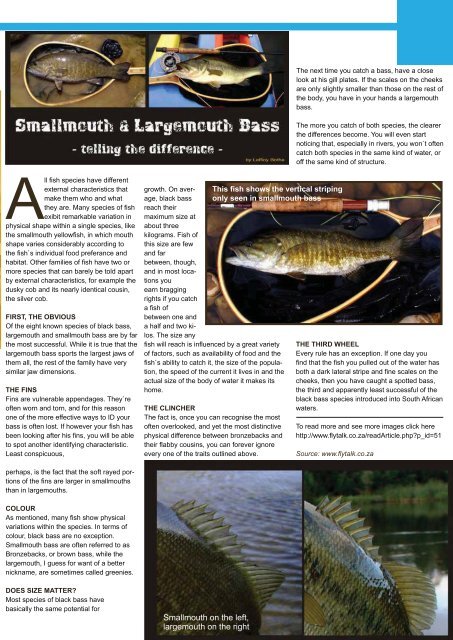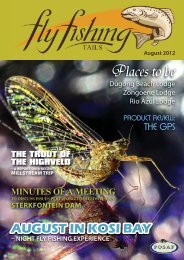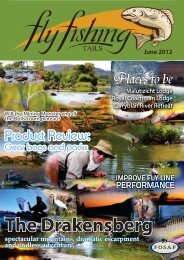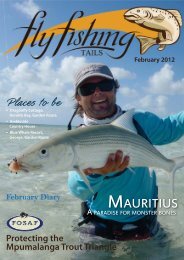Know Your Knots - Flyfishingtails
Know Your Knots - Flyfishingtails
Know Your Knots - Flyfishingtails
You also want an ePaper? Increase the reach of your titles
YUMPU automatically turns print PDFs into web optimized ePapers that Google loves.
All fish species have different<br />
external characteristics that<br />
make them who and what<br />
they are. Many species of fish<br />
exibit remarkable variation in<br />
physical shape within a single species, like<br />
the smallmouth yellowfish, in which mouth<br />
shape varies considerably according to<br />
the fish`s individual food preferance and<br />
habitat. Other families of fish have two or<br />
more species that can barely be told apart<br />
by external characteristics, for example the<br />
dusky cob and its nearly identical cousin,<br />
the silver cob.<br />
FIRST, THE OBVIOUS<br />
Of the eight known species of black bass,<br />
largemouth and smallmouth bass are by far<br />
the most successful. While it is true that the<br />
largemouth bass sports the largest jaws of<br />
them all, the rest of the family have very<br />
similar jaw dimensions.<br />
THE FINS<br />
Fins are vulnerable appendages. They`re<br />
often worn and torn, and for this reason<br />
one of the more effective ways to ID your<br />
bass is often lost. If however your fish has<br />
been looking after his fins, you will be able<br />
to spot another identifying characteristic.<br />
Least conspicuous,<br />
perhaps, is the fact that the soft rayed portions<br />
of the fins are larger in smallmouths<br />
than in largemouths.<br />
COLOUR<br />
As mentioned, many fish show physical<br />
variations within the species. In terms of<br />
colour, black bass are no exception.<br />
Smallmouth bass are often referred to as<br />
Bronzebacks, or brown bass, while the<br />
largemouth, I guess for want of a better<br />
nickname, are sometimes called greenies.<br />
DOES SIZE MATTER?<br />
Most species of black bass have<br />
basically the same potential for<br />
growth. On average,<br />
black bass<br />
reach their<br />
maximum size at<br />
about three<br />
kilograms. Fish of<br />
this size are few<br />
and far<br />
between, though,<br />
and in most locations<br />
you<br />
earn bragging<br />
rights if you catch<br />
a fish of<br />
between one and<br />
a half and two kilos.<br />
The size any<br />
fish will reach is influenced by a great variety<br />
of factors, such as availability of food and the<br />
fish`s ability to catch it, the size of the population,<br />
the speed of the current it lives in and the<br />
actual size of the body of water it makes its<br />
home.<br />
THE CLINCHER<br />
The fact is, once you can recognise the most<br />
often overlooked, and yet the most distinctive<br />
physical difference between bronzebacks and<br />
their flabby cousins, you can forever ignore<br />
every one of the traits outlined above.<br />
Smallmouth on the left,<br />
largemouth on the right<br />
This fish shows the vertical striping<br />
only seen in smallmouth bass<br />
The next time you catch a bass, have a close<br />
look at his gill plates. If the scales on the cheeks<br />
are only slightly smaller than those on the rest of<br />
the body, you have in your hands a largemouth<br />
bass.<br />
The more you catch of both species, the clearer<br />
the differences become. You will even start<br />
noticing that, especially in rivers, you won`t often<br />
catch both species in the same kind of water, or<br />
off the same kind of structure.<br />
THE THIRD WHEEL<br />
Every rule has an exception. If one day you<br />
find that the fish you pulled out of the water has<br />
both a dark lateral stripe and fine scales on the<br />
cheeks, then you have caught a spotted bass,<br />
the third and apparently least successful of the<br />
black bass species introduced into South African<br />
waters.<br />
To read more and see more images click here<br />
http://www.flytalk.co.za/readArticle.php?p_id=51<br />
Source: www.flytalk.co.za







